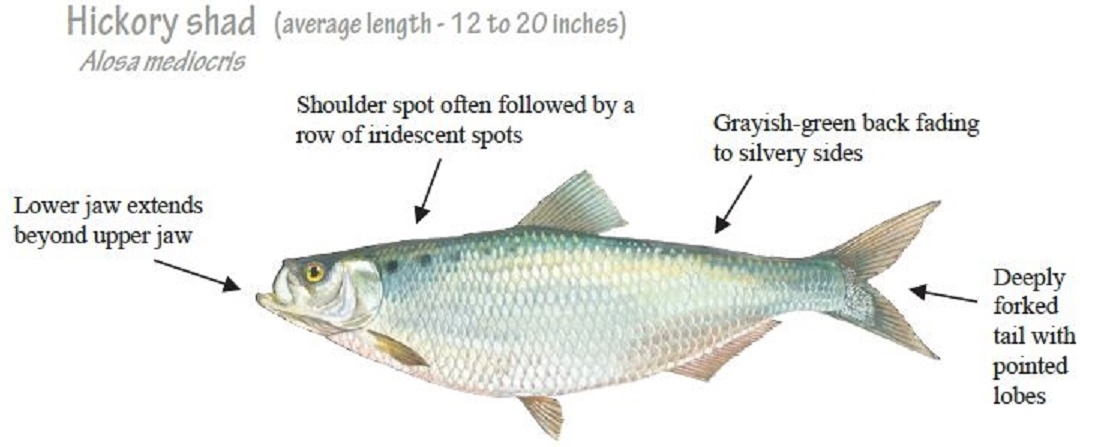River Herring and Shad
Source: Herring and Shad in North Carolina, N.C. Wildlife Resources Commission
Species of river herring and shad (RH/S) once supported large commercial and recreational fisheries along the Atlantic coast. However, the damming of spawning rivers, combined with other habitat degradation and overfishing, have depleted many river herring and shad run populations.
RH/S Management: The Atlantic States Marine Fisheries Commission (ASMFC) has primary management responsibility for river herring and shad. Detailed assessment, catch, and management information can be found on the ASMFC River Herring and Shad page. In recent years, the Mid-Atlantic Fishery Management Council has also become involved in the development of measures to address river herring and shad conservation issues.
RH/S Catch Cap: The Council has focused on limiting incidental catch of river herring and shad in the Atlantic mackerel fishery through a catch cap, which was implemented under Amendment 14 to the Atlantic Mackerel, Squid, and Butterfish Fishery Management Plan (FMP). Additional information about the catch cap can be found at NMFS' quota monitoring site.
River Herring Technical Expert Working Group: The Council also collaborates with NOAA Fisheries and the ASMFC on the Atlantic Coast River Herring Collaborative Forum to help address broader river herring conservation issues. The purpose of the River Herring Forum is to promote the conservation of the species, support information exchange, and encourage collaboration.
Monitoring: The Council reviews monitoring of relevant fisheries annually.
Status
At the October 2016 meeting the Council revisited the issue of whether to add RH/S as Council-managed stocks. Based on a comprehensive review of existing and planned conservation and management efforts, the Council determined that management of RH/S through a Council fishery management plan (FMP) is not warranted. However, the Council reaffirmed its commitment to participating with partners in the conservation and management of RH/S, noting that it will continue to protect RH/S stocks by proactively using the tools provided in the recently-approved Ecosystem Approaches to Fisheries Management (EAFM) Guidance Document. The Council will also continue to use catch caps to incentivize harvesters to reduce river herring and shad bycatch. More information about this decision is available in the press release below.
Meeting Archive
Council Actions
This section provides information and documents related to Council actions that have addressed river herring and shad management. These actions are listed in chronological order.
Amendment 14: River Herring and Shad Bycatch and Monitoring
Amendment 14 was developed by the Council to improve the catch monitoring program for the Atlantic mackerel, squid, and butterfish fisheries, with a focus on better evaluation of the incidental catch of river herring and shad, and to address river herring and shad bycatch issues in the mackerel fishery.
Approved Measures: The final amendment included measures to: (1) Revise vessel reporting requirements (vessel trip reporting frequency, pre-trip and prelanding vessel notification requirements, and requirements for vessel monitoring systems); (2) Expand vessel requirements to maximize observer’s ability to sample catch at-sea; (3) Minimize the discarding of unsampled catch; and (4) Allow the Council to set a cap on river herring and shad catch in the Atlantic mackerel fishery.
Disapproved Measures: NMFS disapproved three measures in Amendment 14 after determining that those measures are inconsistent with the Magnuson-Stevens Fishery Conservation and Management Act (MSA) and other applicable laws. The disapproved measures included: (1) A dealer reporting requirement; (2) A cap that, if achieved, would require vessels discarding catch before it had been sampled by observers (known as slippage) to return to port (This issue has been addressed by a slippage framework action); and (3) A requirement for increased observer coverage on limited access midwater trawl and small-mesh bottom trawl mackerel trips, coupled with an industry contribution of $325 per day toward observer costs (This issue is being further considered via the Industry Funded Monitoring (IFM) Amendment).
Documents:
River Herring and Shad Management (formerly Amendment 15)
In June 2012 the Council initiated an amendment to the Atlantic Mackerel, Squid, and Butterfish FMP to consider whether the existing management framework for river herring and shad was sufficient for conservation and management of these species and whether Federal management under the MSA would address any deficiencies and/or inefficiencies.
At its October 2013 meeting, the Council voted to address additional conservation of river herring and shad through an interagency working group. The Council reviews the progress of the working group on a regular basis (e.g. http://www.mafmc.org/briefing/june-2015) and in October 2016 will conduct an evaluation of the effectiveness of the working group approach and determine if it, or a different strategy, is most appropriate for Council involvement in the conservation of river herring and shad.
Documents:
Press Release: Council Votes to Initiate Interagency Working Group on River Herring and Shad
Scoping Document, November 2012
October 2013 Council Meeting Materials
Briefing Materials- RH/S White Paper (Tab 2-A)
Briefing Materials- Public Comments (Tab 2-B)
Framework 9: Slippage in the Atlantic Mackerel Fishery
Framework Adjustment 9 to the Atlantic Mackerel, Squid, and Butterfish Fishery Management Plan establishes measures to enhance catch monitoring and address slippage (catch that is discarded before it has been sampled by observers) in the Atlantic mackerel fishery. Framework 9 requires Tier 1, 2, and 3 mackerel vessels on observed trips to move 15 nautical miles following an excepted slippage event, which includes safety, mechanical failure, or excess catch of spiny dogfish. These vessels are also required to terminate a fishing trip and immediately return to port following a non-excepted slippage event, which would be due to any reason other than those listed above. In addition to submitting a Released Catch Affidavit, vessels carrying an observer are required to report slippage events through the vessel monitoring system daily catch report for mackerel and longfin squid.




